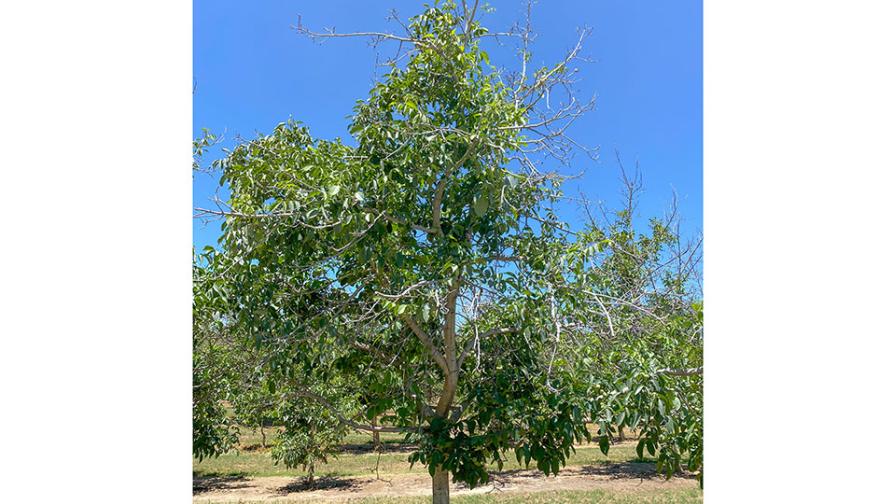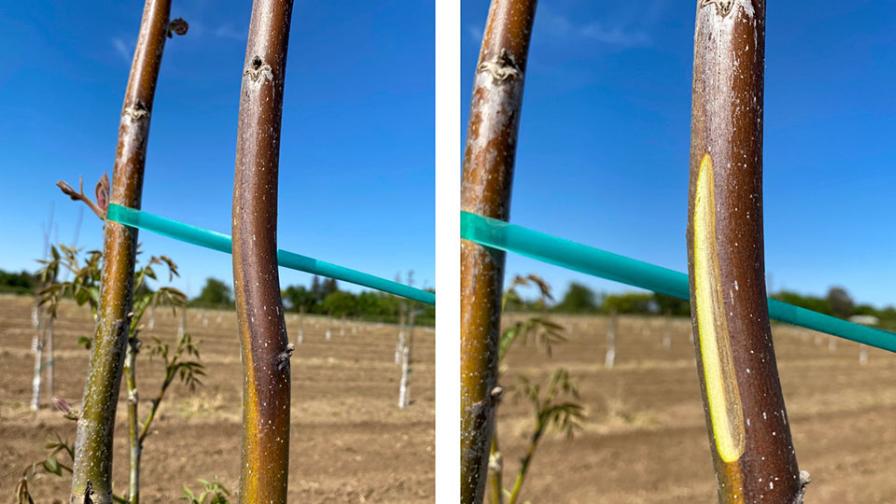Why Walnut Growers Need to Prepare for a Fall Freeze Now

It’s not just young or old walnut trees that can be ravaged by a fall freeze as seen in this ninth-leaf ‘Howard’ specimen near Chico, CA.
Photo by Luke Milliron
Walnut growers in California have been hit with sudden, unexpected freeze events during November in each of the past three years, leading University of California Cooperative Extension (UCCE) farm advisors to issue a warning: Get wet.
Seriously, emphasizes Luke Milliron, UCCE Orchards Advisor in the Northern Sacramento Valley and Janine Hasey, UCCE Farm Advisor Emerita — who have com-posed several reports to prepare growers — irrigation is the only answer they have yet found to reduce damage to walnut trees hit by a freeze.
“Maintaining some surface soil moisture throughout autumn, particularly if growers can look for forecast freezes and irrigate two to three days prior, is the main point we want to stress,” Milliron says. “Hopefully we also get some rain, but that hasn’t been happening how we expect or hope. We wouldn’t be talking about this if we had near-normal rainfall.”
RECENT HISTORY
The first of the recent freezes occurred in 2018 but was overshadowed in the minds of just about everyone in the region because it occurred during the notorious Camp Fire that killed 86 people in Paradise, CA. Another occurred in 2019, but Milliron and Hasey received far more calls from worried growers after last year’s event, which is still being evaluated but is believed to be the most damaging of the three in the Northern Sacramento Valley.
The problem was, ironically enough, possibly due in part to climate change/global warming. Milliron recently sat in on a conference in which experts said climate change will have its biggest effects in the transition seasons, especially winter to spring and fall to winter. During the first two weeks of November 2020, the area weathered high temperatures in the 80s, which is highly unusual. But then on Nov. 10 and 12, temperatures dropped to as low as 25°F, and many of the trees couldn’t take it.
The swing from daytime to nighttime temperatures may explain the severe damage, according to UC-Davis Plant Physiologist Maciej Zwieniecki. In warm temperatures, limbs contain starch, which provides no freeze protection. Slow cooling promotes starch-to-sugar transformation, which protects against ice formation in cells. Temperatures were at times dropping 5 degrees an hour, and the trees weren’t ready. It was a double-whammy, as the trees hadn’t been hardened off by cold nighttime temperatures, and they sustained unseasonably warm daytime highs.

Damage after a fall freeze event can be seen on the southwest side of these second-leaf walnut trees near Gridley, CA.
Photo by Luke Milliron
PREVENTING DAMAGE
If there has not been adequate rainfall by the end of October, Milliron and Hasey recommend irrigating young and mature orchards so the soil is moist going into November. Rainfall adequacy can be deter-mined by comparing rainfall totals with evapotranspiration (ET), and monitoring soil moisture levels by hand or with sensors. Trees with adequate soil moisture are better able to withstand low temperatures without damage than trees that are dry. Water conducts and stores more heat than air spaces.
Continue to actively monitor soil moisture and freeze predictions in November. If a freeze is predicted and the soil is dry, it should be wetted two to three days prior to a freeze event to fill the air spaces so the soil will store more heat. The top foot is the most important and should be at field capacity (not too wet). If there is a dry surface crust, it will prevent the radiation of stored heat during the night. However, avoid standing water on the soil surface before a freeze since it will make the soil surface colder because like a dry crust, it prevents the radiation of stored heat.
If freeze damage is suspected in the fall or winter, cut into the branches, and check the tissue for drying or browning. Subsequent sunburn can further damage tissue on the southwest side of the tree. Paint the southwest side of damaged trees with 50% diluted (1:1 water to paint) white interior latex paint. Painting up to a week after the freeze event can decrease damage by half or more.
As for the future, Milliron says the subject requires a great deal more research, but after three years in a row — walnut growers may just have to get used to preparing for a November freeze.









